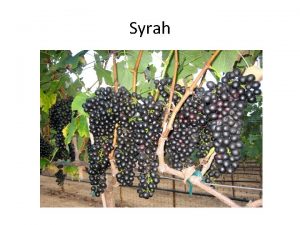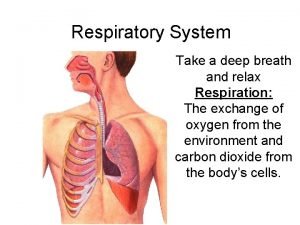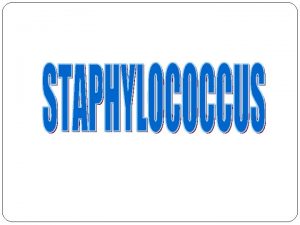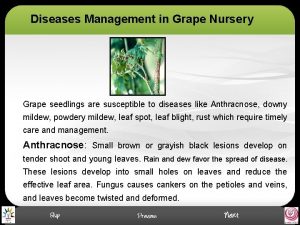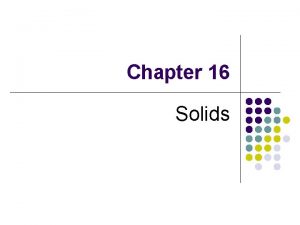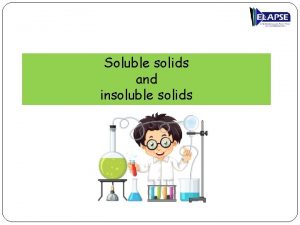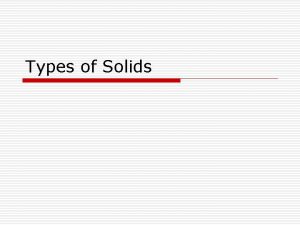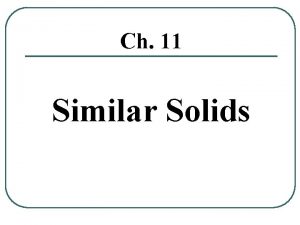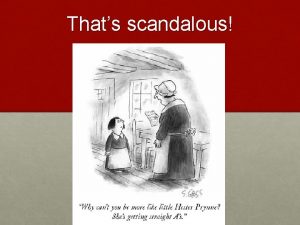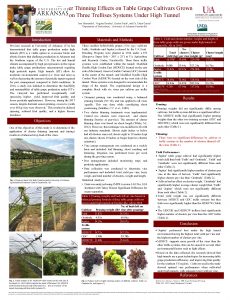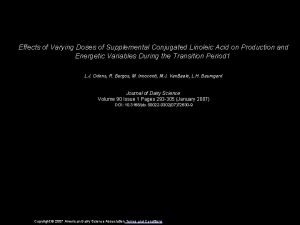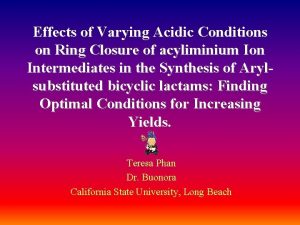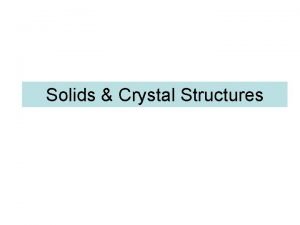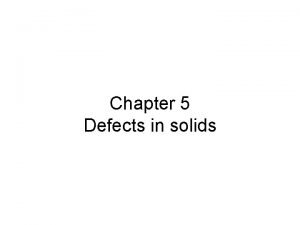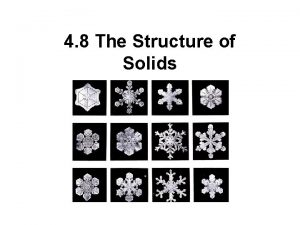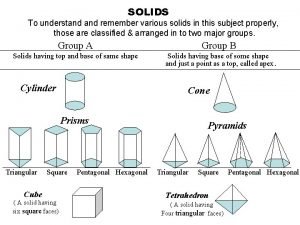The Effects of Varying Levels of Grape Solids


























- Slides: 26

The Effects of Varying Levels of Grape Solids on Fermentation Progress and Off-Character Formation in French Colombard Jonathan Cave Ashley De. Valentine Max Reichwage Lauren Schwarzburg

Introduction

Hypothesis • Low solids levels may inhibit fermentation progress—stuck or sluggish fermentations • High solids will result in rapid fermentation completion • Fermentations with high solids will be more likely to develop negative aroma profiles, particularly H 2 S • Lower solids during fermentations will yield more desirable aromas

Effect of Grape Solids on Fermentation: General Concepts • Grape solids are associated with extraction of astringency, oxidative enzyme activity, interference with fermentation bouquet, and fermentation rate. • White juices fermented with low solids at low temperature are generally considered higher quality. • Low solids tent to slow fermentation and increase potential for stuck fermentations. • Off-character formation is associated with high solids levels during fermentation, particularly the formation of H 2 S.

Off-Character Production and Nutrient Content • Grape solids contain many yeast nutrients. • Settling and racking prior to fermentation decreases total nitrogen by 10 to 15 % (Zoecklein et al. , 1995). • Grape solids retain elemental sulfur and provide protein nitrogen in the form of S-containing amino acids (Boulton et al. , 1996). • Free amino nitrogen (FAN) is linked to H 2 S formation (Vos and Gray, 1979) • Subsequent studies show FAN is not solely responsible.

High Solids and Off-Character Production • Fermentations of six white wine varieties, including French Colombard, showed that wines prepared from clarified juice were higher in quality and desirable aroma than other wines. High solids samples showed absence of fermentation bouquet and increases in off-character, particularly H 2 S (Singleton et al. , 1975). • Study of several cultivars from Greece showed that increasing quantities of grape solids led to increased concentrations of volatile sulfur compounds in all wines except Muscat of Hamburg (Karagiannis and Lanaridis, 2002). • Possible variation amongst varietals.

Low Solids and Off-Character Production • Deficiency of nitrogen and/or vitamins in the must may be directly related to solids level. • Off-character associated with pantothenate deficiency (Boulton et al. , 1996). • Grape solids contain esterases that act as catalysts for hydrolysis of esters—removal of desirable and undesirable esters in high solids samples (Bisson, 2010).

Grape Solids and Fermentation Progress • Grape solids act as a source of nutrients for yeast (Boulton et al. , 1996). • Grape solids provide nucleation sites for carbon dioxide bubbles carrying yeast—increased suspended viable yeast count results in more rapid fermentation in high solids wines (Boulton et al. , 1996). • Solutions supersaturated with carbon dioxide are inhibitory to yeast— grape solids increase fermentation rate by decreasing CO 2 saturation (Boulton et al. , 1996). • Effects of supersaturation rarely seen at fermentation pressures (Boulton et al. , 1996). • Effect of clarification may be related to variety (Houtman and du Plessis, 1986).

Studies on Solids and Fermentation Progress • Clarification removes substances that are essential for yeast proliferation, but the effect of clarification was partially dependent on cultivar. Fermentation rate of French Colombard was more strongly retarded than Chenin blanc or Riesling (Houtman and du Plessis, 1986). • Clarified juices containing less than 0. 1 % solids fermented rapidly if solids were finely ground. Stirring the must during fermentation or addition or rentention of 0. 5 % grape solids resulted in rapid and complete fermentation (Groat and Ough, 1978).

Adsorption of Juice Components to Grape Solids • Yeast growth and byproduct formation are impacted by adsorbed nutrients. • Removal of solids amplifies existing nutrient deficiencies (Boulton et al. , 1996). • Nutrient adjustment, particularly N, significantly impacts the role of solids during fermentation. • Interactions between solids, nitrogen level, fermentation temperature, and yeast strain—addition of grape solids, even in very small quantities, shorten fermentation time, but addition of N increased it further in addition to improving quality (Tromp, 1984)

Materials & Methods

Materials and Methods • Varietal used: 2010 UC-Davis French Colombard • Pressed to 2 mb pressure • Yield: 505 gallons of juice • Cold settled for 24 hours • 7 -10 gallon containers, varying levels of solids.

Solids Levels Sample Solids Added Back (gallons of lees) Percentage of Original Solids A 0 0% B 0. 22 25% C 0. 45 50% D 0. 70 75% E 0. 89 100% F 1. 34 150% G 1. 78 200%

Materials and Methods • Rhone 4600 yeast selected, inoculated at 35 g/h. L • Desirable for short lag phase and low need for nutrients • Ferments easily at low temperatures (13. 5 C)

Materials and Methods • Fermentation carried out at 62 F • Brix and temperature monitored throughout • Racked and bottled for analysis • Analysis by duo trio test and preference test

Results and Discussion

Fermentation Profiles: All Samples 25 25 20 20 Sample A Brix Sample B Brix 15 10 10 Sample C Brix Temperature (C) Corrected Brix 15 Sample D Brix Sample E Brix Sample F Brix Sample G Brix Sample A Temp. Sample C Temp. Sample D Temp. 5 5 Sample E Temp. Sample F Temp. Sample G Temp. Sample B Temp. 0 0 0 -5 50 100 150 200 Time (hours) 250 300 350 400 -5

Fermentation Profile Discussion • The low solids samples did not seem to inhibit the fermentation progression, i. e. no stuck or sluggish fermentations, which contradicts the hypothesis • Yeast must have had sufficient nutrients • The higher the solids levels, the greater the rate of fermentation which agrees with the hypothesis • More solids = more nutrients • Greater amount of nucleation sites for CO 2 thus increasing yeast viability

Final Solids Concentrations Table 1: Mass of solids and calculated concentrations from centrifuged samples Percentage of Original Solids Mass of solids extracted from the centrifuge (g) Calculated Concentration (g/m. L) A 0% 0. 426 0. 00473 B 25% 0. 745 0. 00828 C 50% 0. 672 0. 00747 D 75% 0. 951 0. 0106 E 100% 1. 029 0. 01143 F 150% 1. 188 0. 01320 G 200% 1. 737 0. 01930 Sample Lack of proportionality between the initial solids added and the final solids obtained. Why? • Approximate volumes of lees were added • Different viable yeast counts in each sample effect the final mass of solids obtained • Different keg shaking techniques • Small sample size

Sensory Notes Sample Percentage of Original Solids Aromas & Flavors Noted A 0% Skunky, reductive character B 25% Skunky, reductive character C 50% Clean, very slight skunkiness D 75% Clean, Pinot Grigio, tart E 100% Most complex, tart F 150% Wet, rotten walnut G 200% Wet, rotten walnut

Preference Test Results Table 5: Ranking of the seven different wine samples Rank Sample Points 1 C 61 2 G 55 3 (tie) E 50 3 (tie) F 50 5 D 49 6 A 31 7 B 19 • C (75% of original lees) was most preferred, however samples D through G were all fairly close • A and B are clearly the least preferred wines

Duo-Trio Results Table 2: Number of responses from the fifteen sensory panelists for the different sample Sample 1 Responses Reference C D A F B G E E B A F B D E Sample 2 Responses 12 8 2 9 4 11 5 C D G C F G A 3 7 13 6 11 4 10 Correct Responses 12 8 13 6 11 11 10 Table 3: Percentage of correct duo trio responses for the seven different trials Samples C vs. E D vs. B A vs. G F vs. C B vs. F G vs. D E vs. A Percentage of correct responses 80% 53% 87% 40% 73% 67%

Duo-trio Statistical Analysis Table 4: Summary table of the duo-trio test, showing the z-test values and their respective probability values along with statistical significance at α=0. 05 Samples z-test Probability Statistically significant difference? C vs. E 2. 32 0. 0094 Yes D vs. B 0. 26 0. 3632 No A vs. G 2. 84 0. 0022 Yes F vs. C -0. 77 n/a No B vs. F 1. 81 0. 0322 Yes G vs. D 1. 81 0. 0322 Yes E vs. A 1. 29 0. 0885 No

Conclusion Variability of solid levels in the fermenting wine did not cause sluggish or stuck fermentation at the levels investigated here, though the anticipated trend of increasing fermentation rate in correlation with increasing amounts of solids was observed. It was further determined that variability of solid level in white wine causes a discernable difference in the resulting aroma profile. However, a direct correlation between solid levels and preference cannot be found due to the complex nature of the wine when examined as a solvent matrix.

Works Cited Amerine, M. A. , and Roessler, E. B. 1983. Wines, Their Sensory Evaluation. New York: W. H. Freeman. Atkins, P. , J. de Paula. 2002. Physical Chemistry. W. H. Freeman and Company, New York. Bautista, R. , E. Fernandez, E. Falque. 2007. Effect of the contact with fermentation-lees or commercial lees on the volatile composition of white wines. Eur. Food. Res. Technol. 224: 405 -413. Bisson, L. F. 2010. UC Davis Wine production Course [Online]. Available at http: //enologyaccess. org/EA 2/index. php/wineed/ven 124 listing. html. Boulton, R. B. , V. L. Singleton, L. F. Bisson and R. E. Kunkee. 1996. Principles and Practices of Winemaking. Chapman and Hall. New York, NY. Groat, M. and C. S. Ough. 1978. Effects of Insoluble Solids Added to Clarified Musts on Fermentation Rate, Wine Composition, and Wine Quality. AJEV 29(2): 112 -119. Houtman, A. C. and C. S. du Plessis. 1986. Nutritional Deficiencies of Clarified White Grape Juices and Their Correction in Relation to Fermentation. South African Journal of Enology and Viticulture 7(1): 39 -46. Karagiannis, S. and P. Lanaridis. 2002. Insoluble Grape Material Present in Must Affects the Overall Fermentation Aroma of Dry White Wines Made from Three Grape Cultivars Cultivated in Greece. Journal of Food Science 67(1): 369 -374. Lubbers, S. , C. Charpentier, M. Feuillat, and A. Voilley. 1994. Influence of yeast walls on the behavior of aroma compounds in a model wine. Am. J. Enol. Vit. 45: 29 -33. Meilgaard, M. , Civille, G. V. , and Carr B. T. 2007. Sensory Evaluation Techniques. Boca Raton: Taylor & Francis. Scott Laboratories Online Source (2010). http: //scottlab. com/product-74. aspx. Singleton, V. L. , H. A. Siebrhagen, P. de Wet, and C. J. van Wyk. 1975. Composition and Sensory Qualities of Wines Prepared from White Grapes by Fermentation with and without Grape Solids. AJEV 26(2): 62 -69. Tromp, A. 1984. The Effect of Yeast Strain, Grape Solids, Nitrogen and Temperature on Fermentation Rate and Wine Quality. South African Journal of Enology and Viticulture 5(1): 1 -6. Vos, P. G. A. and R. S. Gray. 1979. The Origin and Control of Hydrogen Sulfide During Fermentation of Grape Must. AJEV 30(3): 187 -197. Zoecklein, B. W. , K. C. Fugelsang, B. H. Gump and F. S. Nury. 1995. Wine Analysis and Production. Chapman and Hall. New York, NY.

Solids Level Tasting • • • Glass 1: Control: Low solids Chardonnay Glass 2: Inocel Glass 3: Fermoclean Glass 4: Fermocasein Glass 5: Control: Low solids French Colombard • Glass 6: 100% solids French Colombard
 Grape solar 390w
Grape solar 390w Grape life cycle
Grape life cycle Dark skinned grape
Dark skinned grape Lungs diagram
Lungs diagram Grape logo
Grape logo Food uncountable or countable
Food uncountable or countable Grape sherbet poem
Grape sherbet poem Gram positive grape like clusters
Gram positive grape like clusters Equation of continuity for time varying fields
Equation of continuity for time varying fields Balanced sentence examples
Balanced sentence examples Interesting sentence structures
Interesting sentence structures Sentence openers
Sentence openers Cobol search varying
Cobol search varying Maxwell 4 equation
Maxwell 4 equation Fappis
Fappis Cobol perform varying decrement
Cobol perform varying decrement Adverb opener examples
Adverb opener examples Varying sentence beginnings
Varying sentence beginnings Varying sentence beginnings
Varying sentence beginnings 3 levels of thinking
3 levels of thinking Phản ứng thế ankan
Phản ứng thế ankan Gấu đi như thế nào
Gấu đi như thế nào Thiếu nhi thế giới liên hoan
Thiếu nhi thế giới liên hoan điện thế nghỉ
điện thế nghỉ Một số thể thơ truyền thống
Một số thể thơ truyền thống Thế nào là hệ số cao nhất
Thế nào là hệ số cao nhất Trời xanh đây là của chúng ta thể thơ
Trời xanh đây là của chúng ta thể thơ


